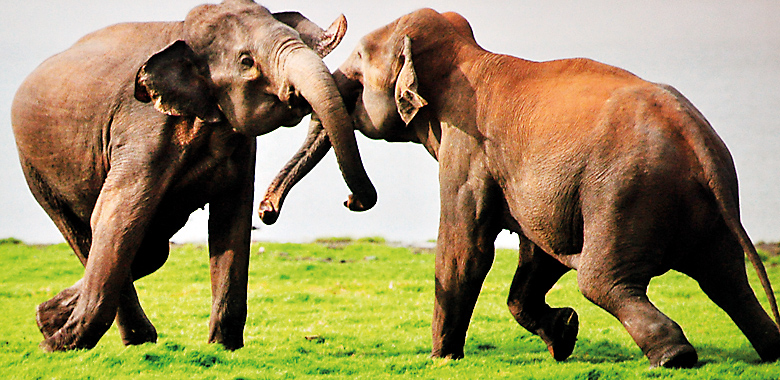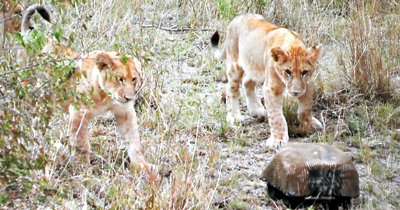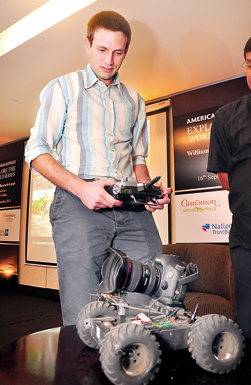Taking a shot at the Lankan wilds with his BeetleCam
The lions of the Maasai Mara sense an intruder amongst them. Rustling the dry blades of grass of the Savannah, a small buggy-like contraption fitted with a DSLR camera crawls up to them. A curious group of lion cubs are the first to investigate as they cautiously paw at it. Fifty metres away in the back of an open top Land Cruiser, British wildlife photographer and inventor of the BeetleCam, William ‘Will’ Burrard-Lucas controls the device with the device. The BeetleCam takes a jolting step forward and clicks away. The cubs are startled but relentless as they close in once more. Then one of them lunges, grabs the camera in its mouth and runs off into the bushes.

Capturing the action: One of Will’s photographs at Minneriya
“A battered BeetleCam, teeth-marks and a brilliant set of pictures was what I got,” laughs Will. Named the BeetleCam as it has the viewpoint of a beetle, this is the tool that got Will into the headlines. “It’s a camera that’s mounted on a set of wheels that is driven around using a remote control and works in the same way a remote controlled aeroplane would. It allows me to get up close with the wildlife and take shots from a totally different perspective.”
The one that was carried away by the playful lion club was an armoured version with a lion-proof carapace, after a curious lioness completely destroyed the earlier model. Thankfully though, the memory chip was safe and Will had retrieved some brilliant pictures.
It was in 2009 that the 30-year-old wildlife photographer set about building this camera -allowing him to take unprecedented close-up shots- with his brother Matthew. A Physics graduate from Imperial College, London, Will had no problems working out the technicalities but took a gamble not knowing whether it would work in the wild.
Contacted by Cinnamon Nature Trails to try out the BeetleCam in Sri Lanka, Will has spent the past ten days photographing local wildlife. “I’ve heard so much about Sri Lankan wildlife, but it’s great to actually be here and discover it.” He used the Beetle Cam on their first visit to Minneriya for the elephant gathering. Although the results weren’t all too great on the first day, due to poor backlighting, Will says that it was a tremendous experience and he’s now on the lookout for leopards at Wilpattu. Will’s hope is to capture unique photographs that can be used to promote wildlife tourism in Sri Lanka.
Speaking at an event held for the public, where Will showcased some of his best shots, Head of Eco tourism, John Keells Hotels, Chitral Jayatilake said that photographs of this nature grab the attention of the world, and ultimately help Sri Lanka reach the goal of becoming the best wildlife destination after Africa.

Hey what’s that: Curious Lioncubs eye the BeetleCam
Will’s passion for wildlife took root in the ‘80s when his father had to move to Tanzania. The Serengeti with its annual migration when more than 1,500,000 wildebeest follow some 200,000 zebra in a 2,000 km round pilgrimage in search of fresh grazing and water -dubbed as the greatest wildlife show on earth- proved an amazing spectacle to him.
However, it was only in 2003 that he got his first digital camera and while reading for his degree did a bit of part-time photography. “Pretty soon my interest in wildlife and photography merged and before I knew it, I even started making a bit of money from it,” he says. “I knew that I wanted to travel to places and do wildlife photography because it had an instant appeal.” He quit an accountancy job in London and became a full-time wildlife photographer.
A trip to the Falklands Islands five years ago was a turning point- his focus being the ‘eccentric’ rockhopper penguins and ‘grumpy’ elephant seals. “I was doing long-lens photography, which meant that you had a very shallow depth of field and you end up getting a lot of blurred images in the background,” Will explains. “I’ve always wanted to get closer to my subject and produce a wide-angle photograph.”
So there he was crawling up to the rockhopper penguins. “The penguins are pretty inquisitive to start off with. Even if you lie down and stay still, they’ll come up, hop onto you and check you out.” The real problem came when he had to photograph animals who were not so happy about being in the frame. “Elephants seals are large creatures weighing up to several tonnes and you wouldn’t want to get in their bad books.” Yet, he found himself crawling close even getting covered in excreta in the process. The pictures were brilliant, but it was a risk.
While in the Komodo Islands off Indonesia, he had tried several experiments with one of the more successful ones seeing him place a camera on a little trolley cart attached to a long pole that he could manoeuvre around. It gave him a metre or two headstart if an animal decided to chase him down.
Will’s experiment was a success, with shots of Komodos so close that you could see the spittle on the tip of their mouths; yet he knew that there was room for much improvement.

Easier than you think: Will demonstrates the use of the BeetleCam at a presentation last Monday. Pic by Mangala Weerasekera
Enter the BeetleCam in 2009- the remote-controlled camouflaged camera that let Will to capture intimate snaps of some of the world’s most fearsome animals, without the risk of being savaged. Although a similar technique was used by BBC’s naturalist and film-maker Sir David Attenborough for large scale films, Will’s BeetleCam is the first time that a single photographer has used it to take animal close-ups.
The trial run was on the elephants, but its real test was to take on the lions of the Massai Mara. The BeetleCam proved no match for the razor-sharp teeth of a lioness. “Should’ve seen that coming,” laughs Will, “But it was worth it.” Back in London, the pictures sold pretty well and people were taking note. “The BeetleCam photos were very different. It was instrumental in getting my work out and of course, people found it amusing that a lion ran off with my camera.” Will even had his images displayed in the Natural History Museum in London and the Smithsonian Museum in Washington DC
By 2011, Will had made several modifications to the initial model including a lion-proof carapace, HD video recording, wireless live-view and remotely operated camera tilt, and now it’s out in the market. “Initially, I never wanted it to be a commercial product, but it worked so well out in the wild that many photographers approached me, requesting it to be available on the market.” The fifth generation of the BeetleCam -much slimmer and more modern in design- is available for £1250.
People may argue that the BeetleCam intrudes on the animals’ personal space. “I suppose there is slight potential to misuse it but you need to respect the animal first and then think of the photos,” Will says. “You have to use it sensibly and responsibly,” he adds. “Being a wildlife photographer, you need to take the risk and set yourself apart, but it should be in the best interest of the animal that you are focusing on.”
The BeetleCam was his tool to get up close with the animals. Aspiring young wildlife photographers need to be inventive, he feels. “Be inventive and take something different. It doesn’t matter if you’re focusing on leopards or monkeys, the most important thing is to be out there, making a connection with the animals.”
Will’s work can be seen on www.burrard-lucas.com or on his facebook page: www.facebook.com/BLPhotography
comments powered by Disqus

